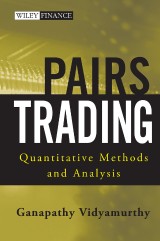Details

Pairs Trading
Quantitative Methods and AnalysisWiley Finance, Band 217 1. Aufl.
|
87,99 € |
|
| Verlag: | Wiley |
| Format: | |
| Veröffentl.: | 23.09.2004 |
| ISBN/EAN: | 9780471684572 |
| Sprache: | englisch |
| Anzahl Seiten: | 224 |
DRM-geschütztes eBook, Sie benötigen z.B. Adobe Digital Editions und eine Adobe ID zum Lesen.
Beschreibungen
The first in-depth analysis of pairs trading<br /> Pairs trading is a market-neutral strategy in its most simple form. The strategy involves being long (or bullish) one asset and short (or bearish) another. If properly performed, the investor will gain if the market rises or falls. Pairs Trading reveals the secrets of this rigorous quantitative analysis program to provide individuals and investment houses with the tools they need to successfully implement and profit from this proven trading methodology. Pairs Trading contains specific and tested formulas for identifying and investing in pairs, and answers important questions such as what ratio should be used to construct the pairs properly.<br /> Ganapathy Vidyamurthy (Stamford, CT) is currently a quantitative software analyst and developer at a major New York City hedge fund.
Preface. <p>Acknowledgments.</p> <p>PART ONE: BACKGROUND MATERIAL.</p> <p>Chapter 1. Introduction.</p> <p>The CAPM Model.</p> <p>Market Neutral Strategy.</p> <p>Pairs Trading.</p> <p>Outline.</p> <p>Audience.</p> <p>Chapter 2. Time Series.</p> <p>Overview.</p> <p>Autocorrelation.</p> <p>Time Series Models.</p> <p>Forecasting.</p> <p>Goodness of Fit versus Bias.</p> <p>Model Choice.</p> <p>Modeling Stock Prices.</p> <p>Chapter 3. Factor Models.</p> <p>Introduction.</p> <p>Arbitrage Pricing Theory.</p> <p>The Covariance Matrix.</p> <p>Application: Calculating the Risk on a Portfolio.</p> <p>Application: Calculation of Portfolio Beta.</p> <p>Application: Tracking Basket Design.</p> <p>Sensitivity Analysis.</p> <p>Chapter 4. Kalman Filtering.</p> <p>Introduction.</p> <p>The Kalman Filter.</p> <p>The Scalar Kalman Filter.</p> <p>Filtering the Random Walk.</p> <p>Application: Example with the Standard & Poor Index.</p> <p>PART TWO: STATISTICAL ARBITRAGE.</p> <p>Chapter 5. Overview.</p> <p>History.</p> <p>Motivation.</p> <p>Cointegration.</p> <p>Applying the Model.</p> <p>A Trading Strategy.</p> <p>Road Map for Strategy Design.</p> <p>Chapter 6. Pairs Selection in Equity Markets.</p> <p>Introduction.</p> <p>Common Trends Cointegration Model.</p> <p>Common Trends Model and APT.</p> <p>The Distance Measure.</p> <p>Interpreting the Distance Measure.</p> <p>Reconciling Theory and Practice.</p> <p>Chapter 7. Testing for Tradability.</p> <p>Introduction.</p> <p>The Linear Relationship.</p> <p>Estimating the Linear Relationship: The Multifactor Approach.</p> <p>Estimating the Linear Relationship: The Regression Approach.</p> <p>Testing Residual for Tradability.</p> <p>Chapter 8. Trading Design.</p> <p>Introduction.</p> <p>Band Design for White Noise.</p> <p>Spread Dynamics.</p> <p>Nonparametric Approach.</p> <p>Regularization.</p> <p>Tying Up Loose Ends.</p> <p>PART THREE: RISK ARBITRAGE PAIRS.</p> <p>Chapter 9. Risk Arbitrage Mechanics.</p> <p>Introduction.</p> <p>History.</p> <p>The Deal Process.</p> <p>Transaction Terms.</p> <p>The Deal Spread.</p> <p>Trading Strategy.</p> <p>Quantitative Aspects.</p> <p>Chapter 10. Trade Execution.</p> <p>Introduction.</p> <p>Specifying the Order.</p> <p>Verifying the Execution.</p> <p>Execution During the Pricing Period.</p> <p>Short Selling.</p> <p>Chapter 11. The Market Implied Merger Probability.</p> <p>Introduction.</p> <p>Implied Probabilities and Arrow-Debreu Theory.</p> <p>The Single-Step Model.</p> <p>The Multistep Model.</p> <p>Reconciling Theory and Practice.</p> <p>Risk Management.</p> <p>Chapter 12. Spread Inversion.</p> <p>Introduction.</p> <p>The Prediction Equation.</p> <p>The Observation Equation.</p> <p>Applying the Kalman Filter.</p> <p>Model Selection.</p> <p>Applications to Trading.</p> <p>Index.</p>
<p><b>GANAPATHY VIDYAMURTHY</b> has been working in the financial markets for nearly a decade. During this time, he created the entire risk management software infrastructure for RBC Dominion Securities in New York, and built valuation models and automated execution strategies for UBS Warburg and JP Morgan Fleming. He is currently the principal of Himalaya Consulting.</p> <p>Beyond finance, Mr. Vidyamurthy’s interests range from discrete optimization to algorithmic music composition—a field in which he is often cited. <p>Mr. Vidyamurthy has a master’s degree in electrical communication engineering from the Indian Institute of Science and a master’s degree from the Courant Institute of Mathematical Sciences of New York University.</p>
<p>Pairs trading is the simplest possible example of employing a market neutral strategy. It involves the trading of securities in pairs comprised of a long position in one security and a short position in the other. If performed properly, an investor will be in the ideal position of gaining in any situation—whether the market rises or falls.</p> <p>Author Ganapathy Vidyamurthy examines two versions of pairs trading that arise in the context of statistical arbitrage and risk arbitrage. He offers a compelling point of view that integrates theory and practice—providing in-depth analysis and insight in both of these cases. Issues encountered when translating theory to practice are addressed in a direct manner, arming the investment professional with the quantitative tools needed to answer key questions relating to this type of trading. <p>Written in an easy, accessible style, the book is a seamless blend of ideas ranging from econometrics, control theory, and operations research to core financial theories like arbitrage pricing theory and the theory of contingent claims. It is organized in three information-packed parts. Part I sets the context for the rest of the book by introducing material on key topics including time series, factor models, and Kalman filtering. <p>Part II of the book details statistical arbitrage pairs, a relative value arbitrage based on the premise that there is a long-run equilibrium between the prices of the stocks comprising the pair. Part III moves on to illustrate the trading techniques and strategies associated with risk arbitrage. This widely practiced arbitrage technique involves pairs trading that arises in the context of corporate events, especially mergers and acquisitions. You’ll also discover why—although they are called arbitrage strategies in the industry—they are by no means risk-free. <p><i>Pairs Trading</i> contains specific and tested formulas for identifying and investing in pairs. To further facilitate an understanding of this method, a bulleted summary highlighting key points is provided at the end of every chapter. Peppered with humor and snippets of history, <i>Pairs Trading</i> provides a framework for and insights on applying rigorous analysis to trading pairs in the equity markets.</p>
Diese Produkte könnten Sie auch interessieren:

Counterparty Credit Risk, Collateral and Funding

von: Damiano Brigo, Massimo Morini, Andrea Pallavicini

69,99 €

Risk Management for Islamic Banks

von: Imam Wahyudi, Fenny Rosmanita, Muhammad Budi Prasetyo, Niken Iwani Surya Putri

55,99 €















